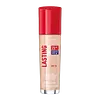What's inside
What's inside
 Key Ingredients
Key Ingredients

 Benefits
Benefits

 Concerns
Concerns

 Ingredients Side-by-side
Ingredients Side-by-side

Water
Skin ConditioningDimethicone
EmollientMica
Cosmetic ColorantBoron Nitride
AbsorbentGlycerin
HumectantButylene Glycol
HumectantPEG/PPG-18/18 Dimethicone
EmulsifyingPhenyl Trimethicone
Skin ConditioningBis-PEG/PPG-14/14 Dimethicone
EmollientSodium Chloride
Masking1,2-Hexanediol
Skin ConditioningCaprylyl Glycol
EmollientCitrus Junos Peel Extract
Skin ConditioningEuterpe Oleracea Fruit Extract
Lactobacillus/Lemon Peel Ferment Extract
Skin ConditioningMethicone
EmollientMethyl Methacrylate Crosspolymer
Silica
AbrasiveSodium Ascorbyl Phosphate
AntioxidantTocopheryl Acetate
AntioxidantTriethoxycaprylylsilane
Trihydroxystearin
Skin ConditioningPhenoxyethanol
PreservativeWater, Dimethicone, Mica, Boron Nitride, Glycerin, Butylene Glycol, PEG/PPG-18/18 Dimethicone, Phenyl Trimethicone, Bis-PEG/PPG-14/14 Dimethicone, Sodium Chloride, 1,2-Hexanediol, Caprylyl Glycol, Citrus Junos Peel Extract, Euterpe Oleracea Fruit Extract, Lactobacillus/Lemon Peel Ferment Extract, Methicone, Methyl Methacrylate Crosspolymer, Silica, Sodium Ascorbyl Phosphate, Tocopheryl Acetate, Triethoxycaprylylsilane, Trihydroxystearin, Phenoxyethanol
Water
Skin ConditioningDicaprylyl Carbonate
EmollientDicaprylyl Ether
EmollientIsododecane
EmollientAluminum Starch Octenylsuccinate
AbsorbentZinc Oxide
Cosmetic ColorantSilica
AbrasiveGlycerin
HumectantCetyl PEG/PPG-10/1 Dimethicone
EmulsifyingTri (Polyglyceryl-3/Lauryl) Hydrogenated Trilinoleate
EmulsifyingTrimethylsiloxysilicate
EmollientNiacinamide
Smoothing2,3-Butanediol
HumectantStearalkonium Bentonite
Gel FormingPropylene Carbonate
SolventTocopheryl Acetate
AntioxidantCaprylic/Capric Triglyceride
MaskingTriethoxycaprylylsilane
Alpha-Glucan Oligosaccharide
CleansingSilica Dimethyl Silylate
EmollientSodium Benzoate
MaskingChlorphenesin
AntimicrobialParfum
MaskingSodium Chloride
MaskingSodium Hyaluronate
HumectantHexyl Cinnamal
PerfumingHexamethylindanopyran
MaskingLimonene
PerfumingCitrus Aurantium Peel Oil
Dimethylmethoxy Chromanol
AntioxidantRosa Damascena Flower Extract
MaskingTocopherol
AntioxidantBenzyl Salicylate
PerfumingLinalool
PerfumingTetramethyl Acetyloctahydronaphthalenes
MaskingGeraniol
PerfumingCitrus Aurantium Bergamia Fruit Oil
MaskingCitronellol
PerfumingAlpha-Isomethyl Ionone
PerfumingLinalyl Acetate
MaskingPentaerythrityl Tetra-Di-T-Butyl Hydroxyhydrocinnamate
AntioxidantIron Oxides
CI 77891
Cosmetic ColorantWater, Dicaprylyl Carbonate, Dicaprylyl Ether, Isododecane, Aluminum Starch Octenylsuccinate, Zinc Oxide, Silica, Glycerin, Cetyl PEG/PPG-10/1 Dimethicone, Tri (Polyglyceryl-3/Lauryl) Hydrogenated Trilinoleate, Trimethylsiloxysilicate, Niacinamide, 2,3-Butanediol, Stearalkonium Bentonite, Propylene Carbonate, Tocopheryl Acetate, Caprylic/Capric Triglyceride, Triethoxycaprylylsilane, Alpha-Glucan Oligosaccharide, Silica Dimethyl Silylate, Sodium Benzoate, Chlorphenesin, Parfum, Sodium Chloride, Sodium Hyaluronate, Hexyl Cinnamal, Hexamethylindanopyran, Limonene, Citrus Aurantium Peel Oil, Dimethylmethoxy Chromanol, Rosa Damascena Flower Extract, Tocopherol, Benzyl Salicylate, Linalool, Tetramethyl Acetyloctahydronaphthalenes, Geraniol, Citrus Aurantium Bergamia Fruit Oil, Citronellol, Alpha-Isomethyl Ionone, Linalyl Acetate, Pentaerythrityl Tetra-Di-T-Butyl Hydroxyhydrocinnamate, Iron Oxides, CI 77891
Ingredients Explained
These ingredients are found in both products.
Ingredients higher up in an ingredient list are typically present in a larger amount.
Glycerin is already naturally found in your skin. It helps moisturize and protect your skin.
A study from 2016 found glycerin to be more effective as a humectant than AHAs and hyaluronic acid.
As a humectant, it helps the skin stay hydrated by pulling moisture to your skin. The low molecular weight of glycerin allows it to pull moisture into the deeper layers of your skin.
Hydrated skin improves your skin barrier; Your skin barrier helps protect against irritants and bacteria.
Glycerin has also been found to have antimicrobial and antiviral properties. Due to these properties, glycerin is often used in wound and burn treatments.
In cosmetics, glycerin is usually derived from plants such as soybean or palm. However, it can also be sourced from animals, such as tallow or animal fat.
This ingredient is organic, colorless, odorless, and non-toxic.
Glycerin is the name for this ingredient in American English. British English uses Glycerol/Glycerine.
Learn more about GlycerinSilica, also known as silicon dioxide, is a naturally occurring mineral. It is used as a fine, spherical, and porous powder in cosmetics.
Though it has exfoliant properties, the function of silica varies depending on the product.
The unique structure of silica enhances the spreadability and adds smoothness, making it a great texture enhancer.
It is also used as an active carrier, emulsifier, and mattifier due to its ability to absorb excess oil.
In some products, tiny microneedles called spicules are made from silica or hydrolyzed sponge. When you rub them in, they lightly polish away dead skin layers and enhance the penetration of active ingredients.
Learn more about SilicaChances are, you eat sodium chloride every day. Sodium Chloride is also known as table salt.
This ingredient has many purposes in skincare: thickener, emulsifier, and exfoliator.
You'll most likely find this ingredient in cleansers where it is used to create a gel-like texture. As an emulsifier, it also prevents ingredients from separating.
There is much debate on whether this ingredient is comedogenic. The short answer - comedogenic ratings don't tell the whole story. Learn more about comegodenic ratings here.
The concensus about this ingredient causing acne seems to be divided. Research is needed to understand if this ingredient does cause acne.
Scrubs may use salt as the primary exfoliating ingredient.
Learn more about Sodium ChlorideTocopheryl Acetate is AKA Vitamin E. It is an antioxidant and protects your skin from free radicals. Free radicals damage the skin by breaking down collagen.
One study found using Tocopheryl Acetate with Vitamin C decreased the number of sunburned cells.
Tocopheryl Acetate is commonly found in both skincare and dietary supplements.
Learn more about Tocopheryl AcetateTriethoxycaprylylsilane is a silicone used to bind and stabilize ingredients.
As an emulsifier, it helps prevent ingredients from separating. This can help elongate the shelf life of products.
Triethoxycaprylylsilane is often used to coat mineral sunscreens ingredients to help give a better feel. It also helps reduce oxidative stress in sunscreens.
Learn more about TriethoxycaprylylsilaneWater. It's the most common cosmetic ingredient of all. You'll usually see it at the top of ingredient lists, meaning that it makes up the largest part of the product.
So why is it so popular? Water most often acts as a solvent - this means that it helps dissolve other ingredients into the formulation.
You'll also recognize water as that liquid we all need to stay alive. If you see this, drink a glass of water. Stay hydrated!
Learn more about Water